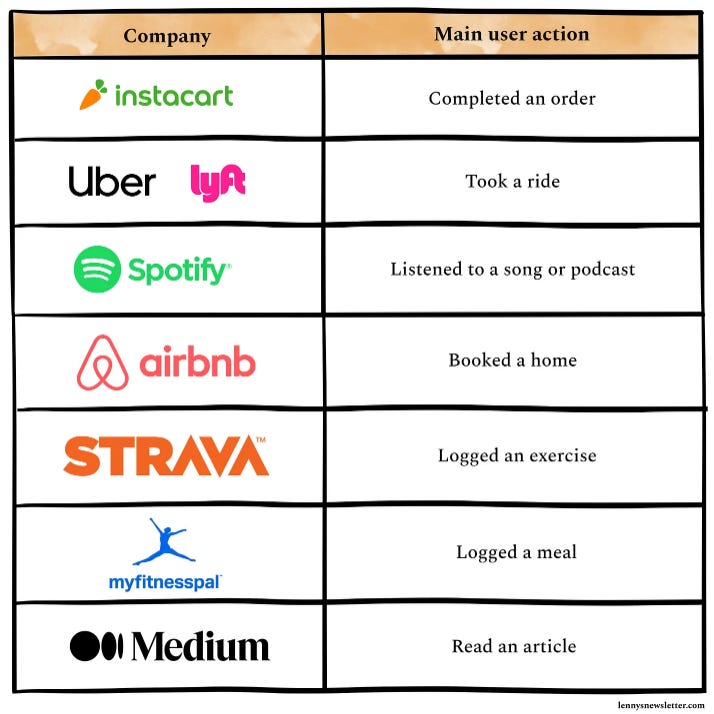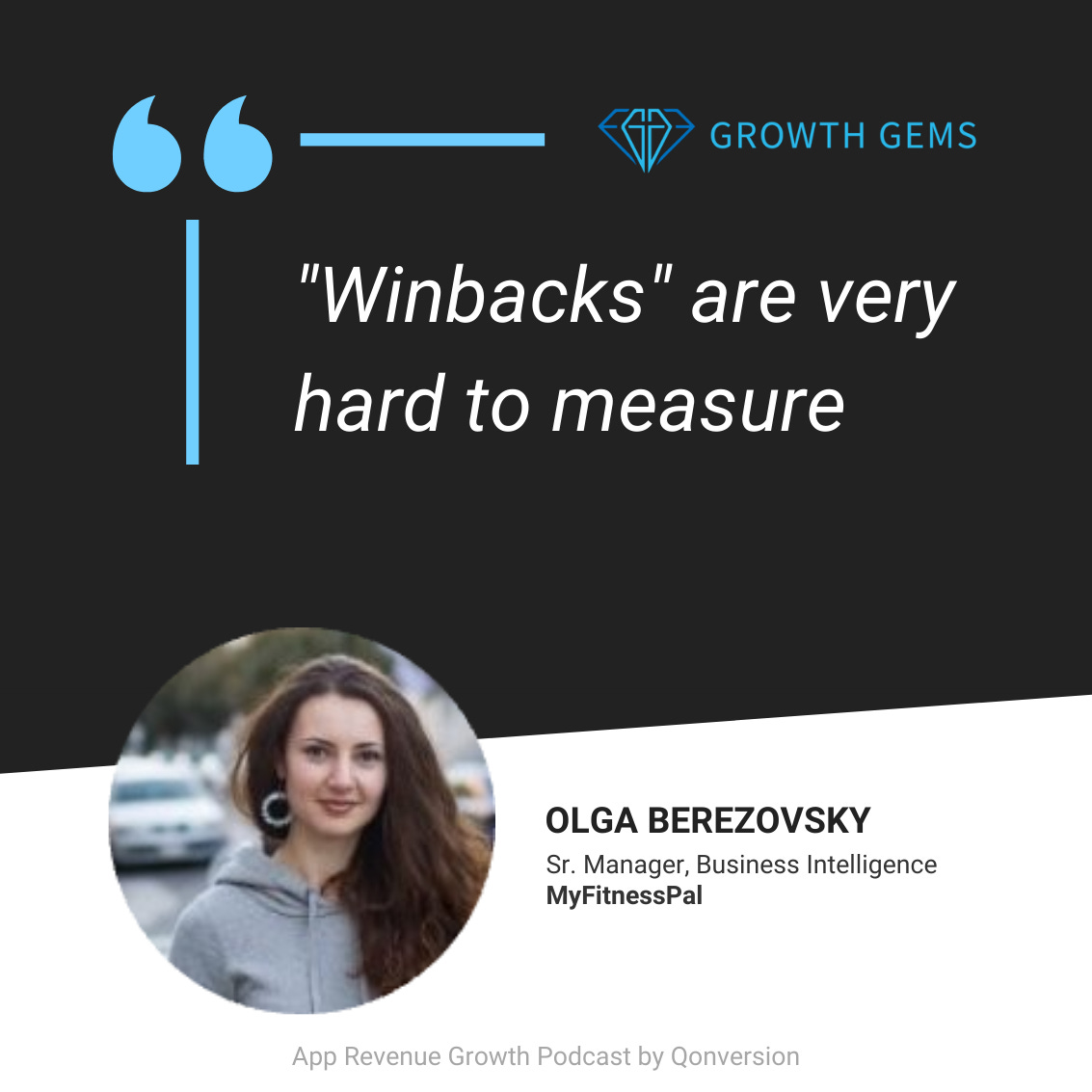💎 Growth Gems #86 - Lifecycle Marketing, Data, and Paid UA
Hey,
This week I’m sharing gems on:
These insights come from Gessica Bicego, Olga Berezovsky, and Tom Hammond.
🥇 TOP GEM OF THE WEEK
Paid Acquisition: creators, creatives
Gessica Bicego (CMO at Paired) is “a computer scientist in love with marketing” and has been in digital marketing and growth for over ten years.
She’s shared a lot before about her experience leading growth at Blinkist.
In Acceptable Unprofitability? How Paired Manages Ad Spend To Hit Home Run, she talked about evaluating performance, content creators, and creatives with Peggy Anne Salz (Founder at MobileGroove) and John Koetsier.
Some good perspectives!
💎 Do not limit yourself to creators and influencers that are only in your niche. Sometimes creators from a different niche can work also, and even better.
Gessica Bicego (CMO at Paired)
at 10:55
⛏️ Going Deeper: Gessica explained that at the beginning of Blinkist, she was limiting herself to Business and Politics creators. She mentioned that different niches like “Health & Fitness” or “Minimalistic Mums” could work just as well.
💎 Basic rules when evaluating creators:
Be proud of the creators you’re engaging and will be associated with
Check the passion they put into their work (will they just be reading bullet points?)
Look at their reach -> engagement rates (10-15% of views to comments is a great ratio)
Gessica Bicego (CMO at Paired)
at 11:53
💎 Look at blended ROI and not just your performance campaigns’ ROI, particularly if you want to test different upper funnel channels. You want to maximize the number of customers for your spend. Example: it’s ok to have some channels not performing as well as others; what you need is the right balance. Gessica has some channels that are 4x as expensive as others.
Gessica Bicego (CMO at Paired)
at 14:50
💎 Test a lot of creatives to find the ones that work. But keep in mind that often a creative might show potential, and you need to double down on it to create the iterations that will become wins. Create at least 5 to 6 concepts or iterations every two weeks.
Gessica Bicego (CMO at Paired)
at 27:08
💎 When it comes to creatives, you must create the emotion that resonates with your brand. You need to make people think. It can be a piece of content, etc., so that when they do see the follow-up performance marketing ad, they click on it. You can have more awareness types of campaigns, work with experts, etc. and then have the ads to close the deal.
Gessica Bicego (CMO at Paired)
at 29:00
💎 Stop depending too much on paid acquisition, and start building your brand.
Gessica Bicego (CMO at Paired)
at 35:50
Data: metrics, a/b testing, retention
Data is the foundation of growth yet is very often overlooked.
In Analytics to Grow Subscription App to 50M+ Monthly Users, Michael Stysin (Co-founder at Qonversion.io) chats with Olga Berezovsky (Sr. Manager, Business Intelligence at MyFitnessPal) about her approach to a/b testing and measuring retention.
If you like this and want to dive deeper, check out Olga’s Data Analysis Journal on Substack.
💎 The main metrics you should track can depend on your growth stage. Three that generally give a good view of your subscription business:
Install to trial
Trial to paid
Churn rate
Olga Berezovsky (Sr. Manager, Business Intelligence at MyFitnessPal)
at 06:45
💎 There are two different types of A/B tests. The process and KPIs you’re looking at will change based on each.
New feature launch: more market research, connect more with your baseline metrics, run forecasts, look at how the population of users might move, and how it will affect the premium offering.
Improvement/Optimization of an existing feature: a more straightforward approach. Formulate a hypothesis, make sure it’s even worth testing, estimate the test runtime for significance, ensure you have the right analytics events, launch to 5%, and if everything is good, ramp up, and run analysis at the end.
Olga Berezovsky (Sr. Manager, Business Intelligence at MyFitnessPal
at 10:00
💎 Develop your A/B testing process and framework within the company before looking for tools.
Olga Berezovsky (Sr. Manager, Business Intelligence at MyFitnessPal
at 12:20
💎 Pros and cons for in-house vs. buy for A/B testing tools:
In-house: struggle with the flexibility it allows
Tools: struggle with integrating with analytics
Olga Berezovsky (Sr. Manager, Business Intelligence at MyFitnessPal
at 12:55
⛏️ Going Deeper: Olga shared that there are some tools you can take advantage of while building the logic in-house, like Eppo. She’s "obsessed with it” because it integrates well with your existing analytics and allows you to A/B test against your own metrics.
She also has a post detailing requirements for an A/B testing platform and where she details the “build” case.
💎 Pricing/offering iterations are very impactful and crucial for the business, but also the most difficult types of tests. Any price testing starts with marketing research.
Olga Berezovsky (Sr. Manager, Business Intelligence at MyFitnessPal
at 14:40
⛏️ Going Deeper: Jake Mor (CEO at Superwall) recently shared how difficult optimizing prices can be in an App Masters episode: “It is so underrated how hard the math is to figure out which prices work best. You can not run one test in June and the other one in July, and think you’re comparing apples to apples”.
💎 It’s tough to move retention. Improvements are typically not seen within months; it can take years.
Olga Berezovsky (Sr. Manager, Business Intelligence at MyFitnessPal
at 20:34
💎 When looking at retention, it matters how you define “active users”. The way you define it should fit into any other engagement metrics you typically track (is it session start, app opens, screen views, main user action, etc.?).
Olga Berezovsky (Sr. Manager, Business Intelligence at MyFitnessPal)
at 21:10
⛏️ Going Deeper: Olga wrote about this in Lenny’s newsletter and recommended using the main user action as the activity event. Some examples below.
💎 Create two different retention metrics: one for free users and one for paid users. For subscriptions, it’s usually easier to look at churn instead of retention.
Olga Berezovsky (Sr. Manager, Business Intelligence at MyFitnessPal)
at 21:45
💎 Two main types of retention:
X-day retention: on which day a % of users come back (e.g., D1, D7, D30)
Unbounded retention: you define a range (e.g., Days 1-5, or Day 5-7)
For subscription businesses, it’s recommended to use X-day retention because you can tie things to your free trial period.
Olga Berezovsky (Sr. Manager, Business Intelligence at MyFitnessPal)
at 22:10
💎 It’s very easy to misread retention in tools like Amplitude if you rely on “any user activity”. You might be over-reporting activities (e.g., due to notifications triggering an activity) and therefore retention. Plus, retention might not be proportional for different segments. You can also miss events happening outside of your app (e.g., change of plans directly in App Store settings).
Olga Berezovsky (Sr. Manager, Business Intelligence at MyFitnessPal)
at 23:05
💎 You need to know each event in your analytics: what it means, when it’s fired, and when it’s not fired. Only then can you create your KPIs and create your reporting.
Olga Berezovsky (Sr. Manager, Business Intelligence at MyFitnessPal)
at 27:08
⛏️ Going Deeper: this reminds me of this gem by Abdala Pineda, where he explains you need to understand technologically how the event is triggered (front-end event, back-end event, triggered when a user clicks, triggered when the user is getting a confirmation pop-up, triggered from a database update, etc.).
💎 It’s very challenging to draw the line between winbacks that happen organically and winbacks that occur because of specific efforts. Example: people subscribe before summer, cancel in September, and resubscribe after Christmas.
Olga Berezovsky (Sr. Manager, Business Intelligence at MyFitnessPal)
at 27:45
💎 Notifications are a good way to get users to re-subscribe. Segmenting and targeting notifications to specific groups often requires matured analytics.
Olga Berezovsky (Sr. Manager, Business Intelligence at MyFitnessPal)
at 29:10
💎 You can monitor cancellation events, so you can send a push notification or trigger an email immediately. Same thing with refunds. It needs to happen immediately, particularly if users still have access to the service.
Michael Stysin (Co-founder at Qonversion.io)
at 29:50
Lifecycle: LiveOps, push notifications
Push notifications are mentioned above as a way to increase retention.
LiveOps are another one, and often good for generating revenue.
Here are some insights on both, shared by Tom Hammond (CEO at UserWise) and Steve Young (Founder at App Masters) in Mastering Retention: How to Design Surprising User Experiences.
💎 LiveOps are a way to create unique and interesting experiences for your users that make them want to come back, so you keep them engaged in activities that can generate revenue without doing a lot of coding.
Tom Hammond (CEO at UserWise)
at 02:05
⛏️ Going Deeper: you need to have some “draw”, and figure out in advance what you could change in your game/app during the LiveOps. You can then use a tool like UserWise to change these variables (it can even be for a specific segment). LiveOps can also be used for more transactional purposes like the Spin & Win Amazon had in the app during Black Friday to draw more people in.
💎 Make sure that any time you’re sending a push notification, you have trust with the user. Each notification needs to bring value to the user. Example of mistake: why would you send a 7am notification if a user has never engaged the app at that time?
Tom Hammond (CEO at UserWise)
at 20:18
💎 Drip campaign template for push notifications:
Day 1: Deliver a quick win
Day 2: Problem + Solution
Day 3: Testimonial
Day 4: Overcome objection
Day 5: Paradigm shift
Day 6: Sales
Day 7: Last chance
Day 7.5: Last hour to save
Steve Young (Founder at App Masters)
at 21:50
🤔 My 2 cents: there are caveats to defining a one-size fits all approach (cf. the quote at the end of the newsletter), but if you do, then I like this sequencing. It’s close to the 7-day new subscriber welcome emails sequence I shared in Growth Gems #72.
💎 Carefully choose when and how you show push notification requests. It’s particularly effective to show the push notification request after giving users something. Example: Playtika Slotomania initially doesn’t ask users for push notifications. Eventually, in the game, you see a spot with a little red dot, and clicking it gives you coins. Only after you find that do they ask you if you want to be notified the next time these gifts become available. If you say yes, they show the push notification request.
Tom Hammond (CEO at UserWise)
at 23:00
💎 An effective push notifications tactic is to send a push message personalized to a specific geo that leads to a free gift. Example: free gift on each country’s independence day, which was particularly effective in Brazil.
Tom Hammond (CEO at UserWise)
at 26:35
💎 Many things go into a user deciding to download an app/game, which already indicates a strong intent: seeing the ad, clicking the ad, looking at the App Store listing, downloading the app, opening the app, etc. Figure out where you failed at getting app openers to retain. The content you’re showing can play a big part (e.g., words chosen and their arrangement for a Word Game).
Tom Hammond (CEO at UserWise)
at 50:10
And before I leave, here is a quote on setting up a one-size fits all push notification copy and frequency:
“It’s never really the majority; it's just the biggest minority of users.” - James Laurain (Head of Growth at Aampe)
See you next time. Stay savvy!
⛏️ Sylvain
🔗 sources:
Acceptable Unprofitability? How Paired Manages Ad Spend To Hit Home Run on the Liftoff’s Mobile Heroes Uncensored
Analytics to Grow Subscription App to 50M+ Monthly Users on Qonversion’s App Revenue Growth Podcast
Mastering Retention: How to Design Surprising User Experiences on App Masters’ Podcast













